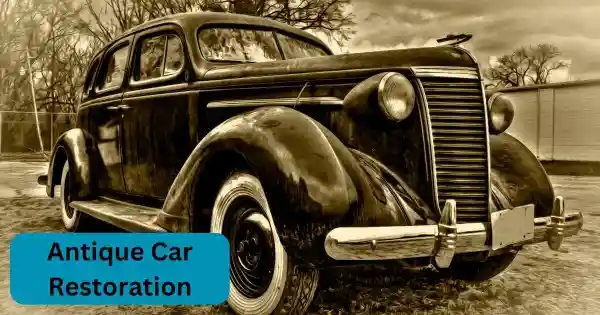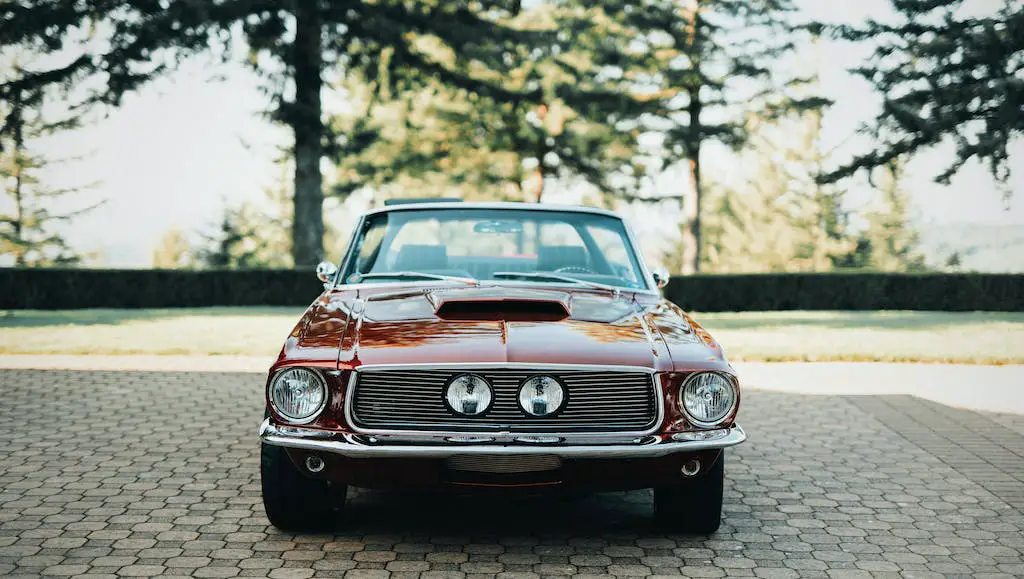Antique automobile restoration transcends mere hobby; it stands as a vibrant odyssey that time-travels the beholder. Within this all-encompassing exposition, we shall furnish you with invaluable discernments, stratagems, and legerdemain to embark upon your sojourn of rejuvenating vintage automobiles. Whether you traverse as a seasoned connoisseur or a nascent initiate, we aspire to endow you with erudition and aplomb to inspire vitality into these age-old masterpieces.
1. Getting Started with Antique Car Restoration
The Fascination of Antique Cars
The restoration of vintage automobiles is not just about mechanics; it’s a journey through history and culture. Each vehicle is a vessel, preserving the stories of eras long gone, and each one is a unique masterpiece. This magnetic charm draws enthusiasts into the world of antique car restoration. Before diving into the intricate details of the restoration process, take a moment to appreciate the historical significance and unparalleled craftsmanship embodied by these vehicular works of art.
Tools and Equipment
Possessing the correct arsenal of tools and equipment is a prerequisite for antique car restoration. Utilizing superior-grade tools can profoundly impact the entire rejuvenation undertaking. Indispensable implements encompass wrenches, pliers, screwdrivers, jacks, and specialized contrivances tailored for the intricacies of vintage vehicle refurbishment. Furthermore, an amply equipped garage, packed with luminous illumination and efficient ventilation, constitutes a pivotal element for accomplishing a triumphant restoration project.


2. Assessing Your Antique Car
Evaluating the Condition
At the inception of every restoration endeavor, the paramount task is to scrutinize the state of your vintage automobile meticulously. A comprehensive examination of the chassis, frame, powerplant, and other constituent parts becomes imperative. Vigilantly record any instances of oxidation, erosion, or impairment. This meticulous evaluation stands as the compass, guiding you in ascertaining the magnitude of the rejuvenation requisite for the project.
Setting Realistic Goals
Before you start disassembling your vehicle, it’s crucial to set realistic goals for your restoration project. Decide the level of restoration you want to achieve, whether it’s a comprehensive, frame-to-frame refurbishment, a partial renewal, or a dedicated preservation project. These goals will guide your time, effort, and financial resources, ensuring a successful and satisfying restoration.
3. Dismantling and Stripping
Safety Precautions
Safety Precautions During Dismantling and Stripping safety should always be your top priority during the dismantling and stripping phase. Wear appropriate safety gear, such as gloves and safety glasses, and use caution when working with power tools. Be mindful of sharp edges and rusty parts. If you’re not experienced with this phase, consider seeking guidance from a professional to avoid accidents and injuries.
Documenting the Process
Documenting Your Antique Car Restoration as you disassemble your car, it’s important to document the process. Take photos and label each component you remove. This documentation will be a valuable reference during reassembly and troubleshooting, ensuring you understand the component placement and can resolve any issues that arise.
4. Restoration of Body and Frame
Repairing Rust and Corrosion
Rust is the archnemesis of antique cars. You’ll need to address rust and corrosion to restore your car’s body and frame. Use rust removers, sandblasting, or other appropriate techniques to eliminate rust. Patch or replace damaged sections of the frame and body.
Replacing Panels
Sometimes, you may need to replace entire panels to restore the body. Finding replacement panels can be challenging, but online resources and specialized suppliers can help you locate the parts required.
5. Engine and Mechanical Components
Cleaning and Rebuilding
Restoring the engine and mechanical components is pivotal to antique car restoration. Start by thoroughly cleaning all parts. Rebuilding the engine may require specialized knowledge, so consult manuals and experts.
Sourcing Replacement Parts
Finding replacement parts for antique cars can be challenging but possible. Devoted suppliers and enthusiasts can help you source the parts you need. Online forums and marketplaces are excellent resources for tracking down rare components.
6. Electrical and Wiring Systems
Rewiring and Upgrading
Antique cars often have outdated electrical systems that may pose safety risks. Rewiring and upgrading the electrical system is essential for a reliable and safe restoration. Use the correct wiring diagrams and ensure proper insulation and connections.
Ensuring Safety
The paramount consideration in any engagement with electrical systems lies in the steadfast commitment to safety. Maintain unwavering vigilance by verifying your work, employing components of the utmost quality, and confirming the steadfast security of all connections. It is imperative to ascertain that the vehicle’s lighting, horn, and all electrical elements are functioning in a state of sound operational readiness.
7. Painting and Finishing
Choosing the Right Paint
Selecting the right paint for your antique car is crucial to achieving an authentic look. Research the original colors and finishes, and choose high-quality automotive paint that matches the era of your vehicle. Proper surface preparation is vital for a flawless paint job.
Achieving a Professional Finish
Achieving a professional finish requires meticulous attention to detail. Proper priming, sanding, and painting techniques will result in a stunning final appearance. Please don’t rush this step; it separates your restored antique car.
8. Reassembly and Final Touches
Paying Attention to Detail
As you reassemble your antique car, pay close attention to every detail. Ensure that all parts are correctly positioned and fastened. Use photographs and documentation from the dismantling phase to guide you. Small details matter and can make a big difference in the final result.
Making It Shine
After completing the reassembly process, allocate time to cleanse and refine each facet of your vintage vehicle meticulously. A splendid and impeccably maintained antique car stands as a bona fide masterpiece. Conclude the process by administering a safeguarding layer of wax or protective coating to conserve the immaculate finish and shield it from the capricious elements.
9. Maintenance and Preservation
Protecting Your Investment
Upon the culmination of your antique car restoration, it becomes imperative to safeguard your valuable asset. Securely house your vehicle within an environment characterized by cleanliness, aridity, and climate control. Conscientiously adhere to a regimen of periodic inspections and maintenance to preemptively avert the emergence of potential issues, thus ensuring the enduring preservation of your cherished investment.
Regular Care and Maintenance
Regular care and maintenance involve routine checks, lubrication, and inspections. They ensure your antique car continues running smoothly and has looked its best for years.
Conclusion
The realm of antique car restoration stands as a strenuous yet profoundly gratifying undertaking. It allows you to imbue vitality into ageless masterpieces, thereby safeguarding the rich tapestry of automotive history for posterity. You can confidently embark upon your personal expedition of antique car rejuvenation through the judicious application of the insights and resources proffered within this compendium. Embrace the multifaceted challenges, assimilate wisdom from each stride, and savor the profound fulfillment derived from transforming a historical relic into a veritable work of art. If you have any queries, please visit this website and click here.
Frequently Asked Questions (FAQs)
Q1: What financial investment is involved in antique car restoration?
The cost of restoring an antique car can vary widely based on the car’s make, model, current condition, and the desired level of restoration. Completely restoring a rare antique car with a full frame-off restoration can cost tens of thousands of dollars. On the other hand, a partial restoration or preservation-focused project may be more affordable. It’s crucial to establish a clear budget and conduct comprehensive research to understand the specific financial considerations for your project.
Q2: Where can I find antique car parts and supplies?
Finding antique car parts and supplies can be challenging but achievable. You can start by searching for specialized antique car parts suppliers online. Additionally, joining antique car enthusiast forums and attending car shows can help you connect with others who may have the parts you need or know where to find them.
Q3: Do I need professional help for antique car restoration?
While many enthusiasts complete antique car restorations on their own, professional help can be invaluable, especially for complex tasks like engine rebuilding or intricate bodywork. Seeking advice or assistance from experienced restorers or professionals can save time and money and ensure a high-quality restoration.
Q4: How long does an antique car restoration project typically take?
The timeline of an antique car restoration project can vary based on many factors, including the extent of the restoration, the availability of necessary components, your expertise, and the time resources at your disposal. While some restorations can be completed within a year, more extensive projects may take several years.
Q5: What’s the most challenging part of antique car restoration?
The most challenging aspects of antique car restoration depend on the specific project. However, many restorers find bodywork, rust removal, and engine rebuilding to be among the most complex and time-consuming tasks. Attention to detail, patience, and a passion for preserving automotive history are essential for overcoming these challenges.

